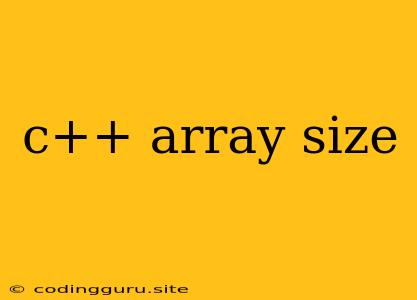Understanding C++ Array Size: A Guide for Beginners
Arrays are fundamental data structures in C++, often used to store collections of elements of the same data type. One crucial aspect of working with arrays is understanding their size. This guide explores the nuances of array size in C++, covering how to declare, access, and manage the size of arrays effectively.
Declaring Arrays: Specifying the Size
In C++, you declare an array by specifying its data type, name, and size. Let's look at a simple example:
int numbers[5]; // Declares an integer array named "numbers" with a size of 5
This declaration creates an array capable of holding 5 integer values. The size you specify within the square brackets ( [ ] ) determines how many elements the array can store.
Accessing Array Elements: Using Indices
Each element in an array is accessed through its index, which is a number starting from 0 and going up to the size of the array minus 1. For instance, in our numbers array:
numbers[0]refers to the first elementnumbers[1]refers to the second elementnumbers[4]refers to the fifth (and last) element
Remember that accessing an element with an index outside the valid range of the array can lead to undefined behavior.
Determining Array Size at Runtime: Using sizeof()
The sizeof() operator provides a way to determine the size of an array at runtime. Here's how it works:
#include
int main() {
int numbers[5];
int size = sizeof(numbers) / sizeof(numbers[0]);
std::cout << "Size of the array: " << size << std::endl; // Output: 5
return 0;
}
In this example, sizeof(numbers) gives the total size of the array in bytes, while sizeof(numbers[0]) gives the size of a single element (an integer in this case). Dividing these two gives you the total number of elements in the array.
Dynamic Array Size: Using std::vector
C++ offers the std::vector class, which provides dynamic arrays. With vectors, you don't need to specify the size beforehand, as they automatically adjust their size as you add or remove elements.
#include
#include
int main() {
std::vector numbers; // Creates an empty vector
numbers.push_back(10); // Adds an element to the vector
numbers.push_back(20);
numbers.push_back(30);
int size = numbers.size();
std::cout << "Size of the vector: " << size << std::endl; // Output: 3
return 0;
}
Avoiding Overflow: Keeping Track of the Size
It is crucial to understand that exceeding the declared array size will result in undefined behavior. You can avoid this by:
- Explicitly checking the size: Before accessing an element, check if the index is within the valid range.
- Using a separate variable: Keep a track of the number of elements you've filled in the array, and never access elements beyond this count.
- Employing
std::vector: As mentioned earlier, vectors handle memory management and size adjustments automatically, minimizing the risk of overflows.
Best Practices for Array Size
- Prefer
std::vectorfor dynamic arrays: Vectors offer better memory management and safety compared to traditional C-style arrays. - Clearly define the size: Determine the maximum number of elements your array will need and declare it accordingly.
- Be mindful of overflow: Always check if the index you're accessing is within the valid range to avoid unexpected behavior.
- Use the
sizeof()operator judiciously: Calculate the size of arrays at runtime to ensure correct memory allocation.
Conclusion
Understanding array size is essential for working effectively with arrays in C++. By understanding how to declare, access, and manage their size, you can leverage these versatile data structures for storing and processing collections of data efficiently. Remember to choose the appropriate method for managing array size based on your specific needs and prioritize code safety to avoid potential errors.
